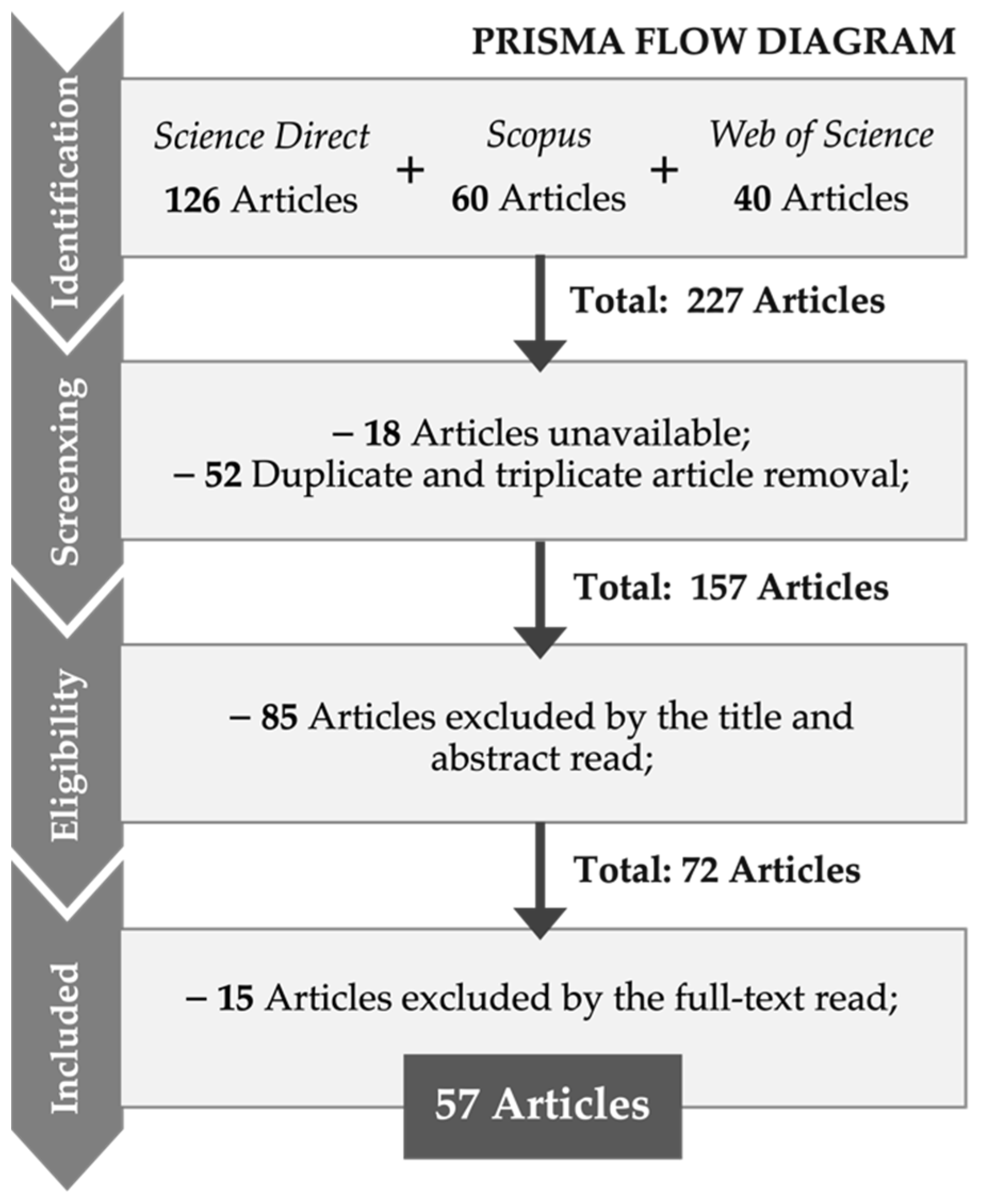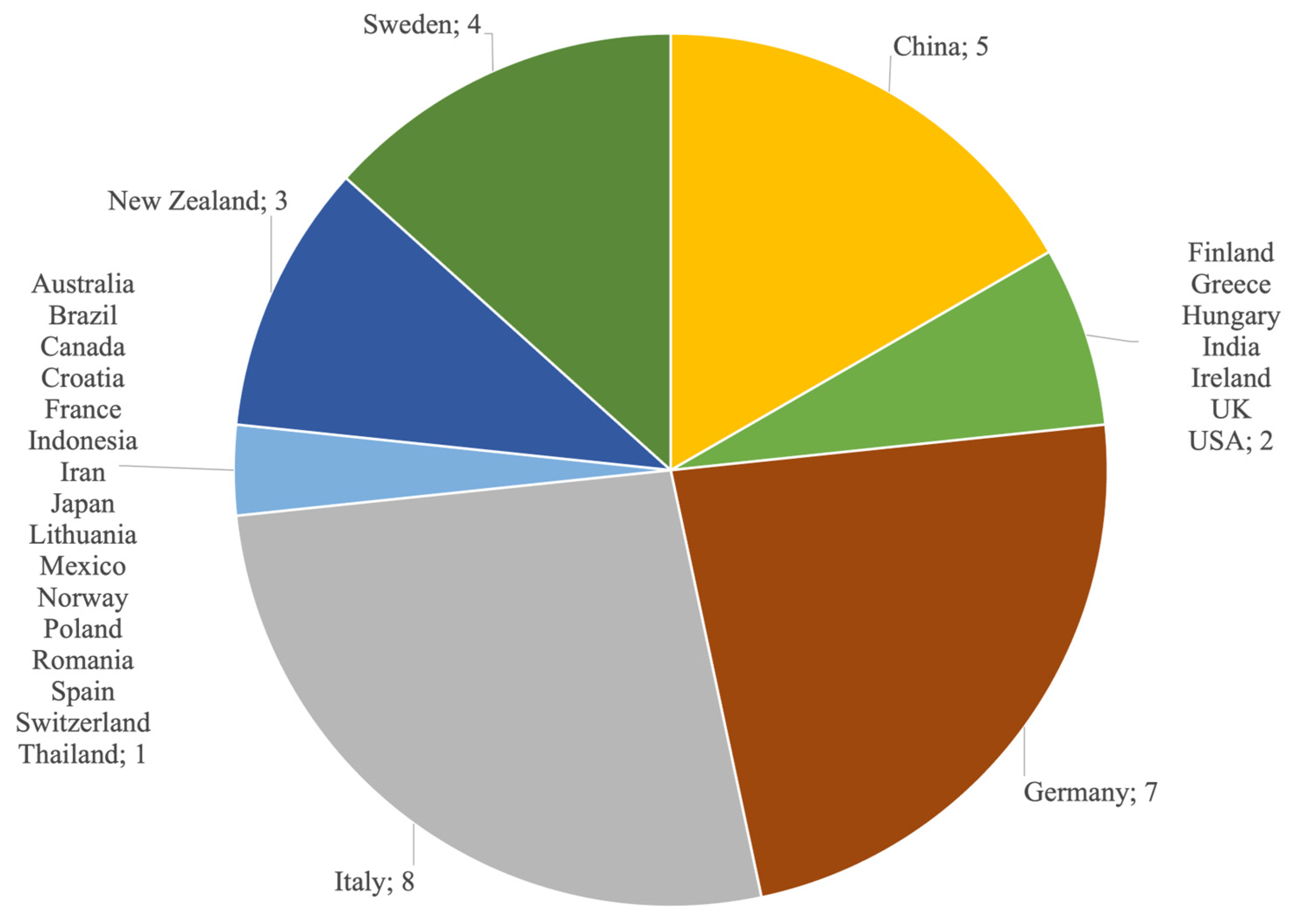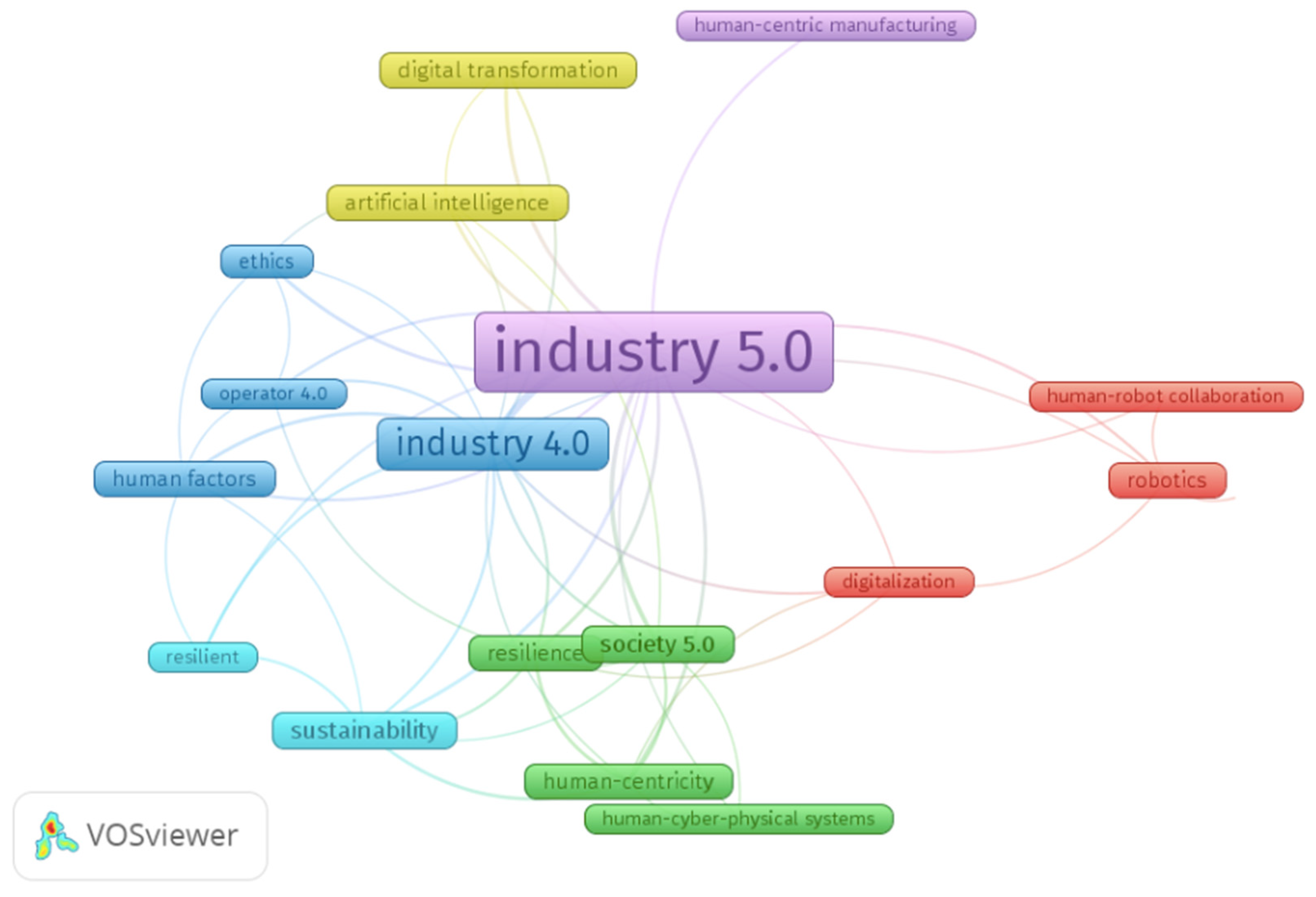Is Industry 5.0 a Human-Centred Approach? A Systematic Review
Abstract
1. Introduction
2. Materials and Methods
2.1. Focus Questions
- (1)
- Is Industry 5.0 truly human-centric oriented?
- (2)
- How can we create human-centricity with Industry 5.0 technologies?
2.2. Information Sources and Data Collection Process
2.3. Eligibility Criteria
2.4. Principle Findings
3. Review of Extracted Research
3.1. Industry 5.0—Concept, Ideology, and Proposals
3.2. Industry 5.0 Technologies
3.3. Human-Centricity in Future Industrial Environments
4. Discussion
4.1. Industry 5.0—Industrial Perspective and in Society
4.2. Human Centricity with Industry 5.0 Technologies
4.3. Operator of Industry 5.0
4.4. Challenges, Limitations, and Future Agenda
5. Conclusions
Author Contributions
Funding
Data Availability Statement
Acknowledgments
Conflicts of Interest
References
- Moller, D.P.F.; Vakilzadian, H.; Haas, R.E. From Industry 4.0 towards Industry 5.0. In Proceedings of the IEEE International Conference on Electro Information Technology, Mankato, MN, USA, 19–21 May 2022; pp. 61–68. [Google Scholar] [CrossRef]
- Huang, S.; Wang, B.; Li, X.; Zheng, P.; Mourtzis, D.; Wang, L. Industry 5.0 and Society 5.0—Comparison, complementation and co-evolution. J. Manuf. Syst. 2022, 64, 424–428. [Google Scholar] [CrossRef]
- Xu, X.; Lu, Y.; Vogel-Heuser, B.; Wang, L. Industry 4.0 and Industry 5.0—Inception, conception and perception. J. Manuf. Syst. 2021, 61, 530–535. [Google Scholar] [CrossRef]
- Mourtzis, D.; Angelopoulos, J.; Panopoulos, N. A Literature Review of the Challenges and Opportunities of the Transition from Industry 4.0 to Society 5.0. Energies 2022, 15, 6276. [Google Scholar] [CrossRef]
- Breque, M.; De Nul, L.; Petrides, A. Industry 5.0—Towards a Sustainable, Human-Centric and Resilient European Industry; European Commission: Brussels, Belgium, 2021. [Google Scholar] [CrossRef]
- Grabowska, S.; Saniuk, S.; Gajdzik, B. Industry 5.0: Improving humanization and sustainability of Industry 4.0. Scientometrics 2022, 127, 3117–3144. [Google Scholar] [CrossRef] [PubMed]
- Saniuk, S.; Grabowska, S.; Straka, M. Identification of Social and Economic Expectations: Contextual Reasons for the Transformation Process of Industry 4.0 into the Industry 5.0 Concept. Sustainability 2022, 14, 1391. [Google Scholar] [CrossRef]
- Ivanov, D. The Industry 5.0 framework: Viability-based integration of the resilience, sustainability, and human-centricity perspectives. Int. J. Prod. Res. 2022. [Google Scholar] [CrossRef]
- Liberati, A.; Altman, D.G.; Tetzlaff, J.; Mulrow, C.; Gøtzsche, P.C.; Ioannidis, J.P.A.; Clarke, M.; Devereaux, P.J.; Kleijnen, J.; Moher, D. The PRISMA Statement for Reporting Systematic Reviews and Meta-Analyses of Studies That Evaluate Health Care Interventions: Explanation and Elaboration. PLoS Med. 2009, 6, e1000100. [Google Scholar] [CrossRef] [PubMed]
- Snyder, H. Literature review as a research methodology: An overview and guidelines. J. Bus. Res. 2019, 104, 333–339. [Google Scholar] [CrossRef]
- Van Eck, N.J.; Waltman, L. Software survey: VOSviewer, a computer program for bibliometric mapping. Scientometrics 2010, 84, 523–538. [Google Scholar] [CrossRef] [PubMed]
- Borchardt, M.; Pereira, G.M.; Milan, G.S.; Scavarda, A.R.; Nogueira, E.O.; Poltosi, L.A. Industry 5.0 Beyond Technology: An Analysis Through the Lens of Business and Operations Management Literature. Organizacija 2022, 55, 305–321. [Google Scholar] [CrossRef]
- Di Nardo, M.; Yu, H. Special Issue “Industry 5.0: The Prelude to the Sixth Industrial Revolution”. Appl. Syst. Innov. 2021, 4, 45. [Google Scholar] [CrossRef]
- Madsen, D.; Berg, T. An Exploratory Bibliometric Analysis of the Birth and Emergence of Industry 5.0. Appl. Syst. Innov. 2021, 4, 87. [Google Scholar] [CrossRef]
- Maddikunta, P.K.R.; Pham, Q.-V.; Prabadevi, B.; Deepa, N.; Dev, K.; Gadekallu, T.R.; Ruby, R.; Liyanage, M. Industry 5.0: A survey on enabling technologies and potential applications. J. Ind. Inf. Integr. 2021, 26, 100257. [Google Scholar] [CrossRef]
- Madhavan, M.; Wangtueai, S.; Sharafuddin, M.A.; Chaichana, T. The Precipitative Effects of Pandemic on Open Innovation of SMEs: A Scientometrics and Systematic Review of Industry 4.0 and Industry 5.0. J. Open Innov. Technol. Mark. Complex. 2022, 8, 152. [Google Scholar] [CrossRef]
- Martins, Y.S.; Domingues, J.P.T.; Poltronieri, C.F.; Leite, L.R. The emergence of Industry 5.0: A bibliometric analysis. In Proceedings of the International Conference on Quality Engineering and Management, Braga, Portugal, 14–15 July 2022; pp. 837–852. [Google Scholar]
- Leng, J.; Sha, W.; Wang, B.; Zheng, P.; Zhuang, C.; Liu, Q.; Wuest, T.; Mourtzis, D.; Wang, L. Industry 5.0: Prospect and retrospect. J. Manuf. Syst. 2022, 65, 279–295. [Google Scholar] [CrossRef]
- Nahavandi, S. Industry 5.0—A Human-Centric Solution. Sustainability 2019, 11, 4371. [Google Scholar] [CrossRef]
- Ghobakhloo, M.; Iranmanesh, M.; Mubarak, M.F.; Mubarik, M.; Rejeb, A.; Nilashi, M. Identifying industry 5.0 contributions to sustainable development: A strategy roadmap for delivering sustainability values. Sustain. Prod. Consum. 2022, 33, 716–737. [Google Scholar] [CrossRef]
- Longo, F.; Padovano, A.; Umbrello, S. Value-Oriented and Ethical Technology Engineering in Industry 5.0: A Human-Centric Perspective for the Design of the Factory of the Future. Appl. Sci. 2020, 10, 4182. [Google Scholar] [CrossRef]
- Prassida, G.F.; Asfari, U. A conceptual model for the acceptance of collaborative robots in industry 5.0. Procedia Comput. Sci. 2022, 197, 61–67. [Google Scholar] [CrossRef]
- Aslam, F.; Aimin, W.; Li, M.; Ur Rehman, K. Innovation in the Era of IoT and Industry 5.0: Absolute Innovation Management (AIM) Framework. Information 2020, 11, 124. [Google Scholar] [CrossRef]
- Bitsch, G. Conceptions of Man in Human-Centric Cyber-Physical Production Systems. Procedia CIRP 2022, 107, 1439–1443. [Google Scholar] [CrossRef]
- Wang, B.; Zheng, P.; Yin, Y.; Shih, A.; Wang, L. Toward human-centric smart manufacturing: A human-cyber-physical systems (HCPS) perspective. J. Manuf. Syst. 2022, 63, 471–490. [Google Scholar] [CrossRef]
- Khan, A.A.; Abonyi, J. Information sharing in supply chains—Interoperability in an era of circular economy. Clean. Logist. Supply Chain 2022, 5, 100074. [Google Scholar] [CrossRef]
- Maier, M.; Ebrahimzadeh, A.; Beniiche, A.; Rostami, S. The Art of 6G (TAO 6G): How to wire Society 5.0 [Invited]. J. Opt. Commun. Netw. 2021, 14, A101–A112. [Google Scholar] [CrossRef]
- Fraga-Lamas, P.; Varela-Barbeito, J.; Fernandez-Carames, T.M. Next Generation Auto-Identification and Traceability Technologies for Industry 5.0: A Methodology and Practical Use Case for the Shipbuilding Industry. IEEE Access 2021, 9, 140700–140730. [Google Scholar] [CrossRef]
- Kaasinen, E.; Anttila, A.-H.; Heikkilä, P.; Laarni, J.; Koskinen, H.; Väätänen, A. Smooth and Resilient Human–Machine Teamwork as an Industry 5.0 Design Challenge. Sustainability 2022, 14, 2773. [Google Scholar] [CrossRef]
- Turner, C.J.; Garn, W. Next generation DES simulation: A research agenda for human centric manufacturing systems. J. Ind. Inf. Integr. 2022, 28, 100354. [Google Scholar] [CrossRef]
- Coronado, E.; Kiyokawa, T.; Ricardez, G.A.G.; Ramirez-Alpizar, I.G.; Venture, G.; Yamanobe, N. Evaluating quality in human-robot interaction: A systematic search and classification of performance and human-centered factors, measures and metrics towards an industry 5.0. J. Manuf. Syst. 2022, 63, 392–410. [Google Scholar] [CrossRef]
- Kolaei, A.Z.; Hedayati, E.; Khanzadi, M.; Amiri, G.G. Challenges and opportunities of augmented reality during the construction phase. Autom. Constr. 2022, 143, 104586. [Google Scholar] [CrossRef]
- Doyle-Kent, M.; Kopacek, P. Adoption of Collaborative Robotics in Industry 5.0. An Irish industry case study. IFAC-PapersOnLine 2021, 54, 413–418. [Google Scholar] [CrossRef]
- Mourtzis, D.; Angelopoulos, J.; Papadokostakis, M.; Panopoulos, N. Design for 3D Printing of a Robotic Arm Tool Changer under the framework of Industry 5.0. Procedia CIRP Mater. Asp. Manuf. Process. 2022, 115, 178–183. [Google Scholar] [CrossRef]
- Colla, V.; Matino, R.; Schröder, A.; Schivalocchi, M.; Romaniello, L. Human-Centered Robotic Development in the Steel Shop: Improving Health, Safety and Digital Skills at the Workplace. Metals 2021, 11, 647. [Google Scholar] [CrossRef]
- Nourmohammadi, A.; Fathi, M.; Ng, A.H. Balancing and scheduling assembly lines with human-robot collaboration tasks. Comput. Oper. Res. 2021, 140, 105674. [Google Scholar] [CrossRef]
- Montini, E.; Cutrona, V.; Bonomi, N.; Landolfi, G.; Bettoni, A.; Rocco, P.; Carpanzano, E. An IIoT Platform For Human-Aware Factory Digital Twins. Procedia CIRP 2022, 107, 661–667. [Google Scholar] [CrossRef]
- Eriksson, K.; Alsaleh, A.; Behzad Far, S.; Stjern, D. Applying Digital Twin Technology in Higher Education: An Automation Line Case Study. Adv. Transdiscipl. Eng. 2022, 21, 461–472. [Google Scholar] [CrossRef]
- Kaarlela, T.; Arnarson, H.; Pitkäaho, T.; Shu, B.; Solvang, B.; Pieskä, S. Common Educational Teleoperation Platform for Robotics Utilizing Digital Twins. Machines 2022, 10, 577. [Google Scholar] [CrossRef]
- Pozo, E.; Patel, N.; Schrödel, F. Collaborative Robotic Environment for Educational Training in Industry 5.0 Using an Open Lab Approach. IFAC-PapersOnLine 2022, 55, 314–319. [Google Scholar] [CrossRef]
- Li, C.; Zheng, P.; Yin, Y.; Pang, Y.M.; Huo, S. An AR-assisted Deep Reinforcement Learning-based approach towards mutual-cognitive safe human-robot interaction. Robot. Comput. Manuf. 2023, 80, 102471. [Google Scholar] [CrossRef]
- Ciobanu, A.C.; Meșniță, G. AI Ethics for Industry 5.0—From Principles to Practice. In Proceedings of the Workshop of I-ESA’22, Valencia, Spain, 23–24 March 2022. [Google Scholar]
- Khamaisi, R.K.; Brunzini, A.; Grandi, F.; Peruzzini, M.; Pellicciari, M. UX assessment strategy to identify potential stressful conditions for workers. Robot. Comput. Manuf. 2022, 78, 102403. [Google Scholar] [CrossRef]
- Melendez, S.; Sima, X.; Coudert, T.; Geneste, L.; de Valroger, A. An experience feedback process for learning from collaboration experiences. Comput. Ind. 2022, 141, 103693. [Google Scholar] [CrossRef]
- Wan, P.K.; Leirmo, T.L. Human-centric zero-defect manufacturing: State-of-the-art review, perspectives, and challenges. Comput. Ind. 2023, 144, 103792. [Google Scholar] [CrossRef]
- Orso, V.; Ziviani, R.; Bacchiega, G.; Bondani, G.; Spagnolli, A.; Gamberini, L. Employee-centric innovation: Integrating participatory design and video-analysis to foster the transition to Industry 5.0. Comput. Ind. Eng. 2022, 173, 108661. [Google Scholar] [CrossRef]
- Wang, L. A futuristic perspective on human-centric assembly. J. Manuf. Syst. 2021, 62, 199–201. [Google Scholar] [CrossRef]
- Rannertshauser, P.; Kessler, M.; Arlinghaus, J.C. Human-centricity in the design of production planning and control systems: Human-centricity in the and control control systems: Systems: Human-centricity in A the approach towards Industry Human-centricity in design control A first approach towards tow. IFAC PapersOnLine 2022, 55, 2641–2646. [Google Scholar] [CrossRef]
- Brunzini, A.; Peruzzini, M.; Grandi, F.; Khamaisi, R.K.; Pellicciari, M. A Preliminary Experimental Study on the Workers’ Workload Assessment to Design Industrial Products and Processes. Appl. Sci. 2021, 11, 12066. [Google Scholar] [CrossRef]
- Mladineo, M.; Cubic, M.; Gjeldum, N.; Crnjaczizic, M. Human-centric approach of the Lean management as an enabler of Industry 5.0 in SMEs. In Proceedings of the International Conference Mechanical Technologies and Structural Materials, Split, Croatia, 23–24 September 2021; pp. 111–117. [Google Scholar]
- Fonda, E.; Meneghetti, A. The Human-Centric SMED. Sustainability 2022, 14, 514. [Google Scholar] [CrossRef]
- Kolade, O.; Owoseni, A. Employment 5.0: The work of the future and the future of work. Technol. Soc. 2022, 71, 102086. [Google Scholar] [CrossRef]
- Brauner, P.; Ziefle, M. Beyond playful learning—Serious games for the human-centric digital transformation of production and a design process model. Technol. Soc. 2022, 71, 102140. [Google Scholar] [CrossRef]
- Eriksson, K.; Chirumalla, K.; Myrelid, P.; Ericsson, M.; Granlund, A.; Håkansson, L.; Johansson, D. Experiences in Running a Professional Course on Digitally-Enabled Production in Collaboration Between Three Swedish Universities. Adv. Transdiscipl. Eng. 2022, 21, 653–664. [Google Scholar] [CrossRef]
- Carayannis, E.G.; Dezi, L.; Gregori, G.; Calo, E. Smart Environments and Techno-centric and Human-Centric Innovations for Industry and Society 5.0: A Quintuple Helix Innovation System View Towards Smart, Sustainable, and Inclusive Solutions. J. Knowl. Econ. 2021, 13, 926–955. [Google Scholar] [CrossRef]
- Lu, Y.; Zheng, H.; Chand, S.; Xia, W.; Liu, Z.; Xu, X.; Wang, L.; Qin, Z.; Bao, J. Outlook on human-centric manufacturing towards Industry 5.0. J. Manuf. Syst. 2022, 62, 612–627. [Google Scholar] [CrossRef]
- Adel, A. Future of industry 5.0 in society: Human-centric solutions, challenges and prospective research areas. J. Cloud Comput. 2022, 11, 40. [Google Scholar] [CrossRef]
- Chaudhari, P.; Utgikar, R.; Kelkar, B.; Borse, P. A Novel Approach: Bioeconomy Industry 5.0 Enhanced version. In Proceedings of the IEEE Pune Section International Conference, Pune, India, 16–19 December 2021; IEEE: New York, NY, USA, 2021; pp. 1–6. [Google Scholar] [CrossRef]
- Del Giudice, M.; Scuotto, V.; Orlando, B.; Mustilli, M. Toward the human-centered approach. A revised model of individual acceptance of AI. Hum. Resour. Manag. Rev. 2021, 33, 100856. [Google Scholar] [CrossRef]
- Doyle Kent, M.; Kopacek, P. Do We Need Synchronization of the Human and Robotics to Make Industry 5.0 a Success Story? In ISPR 2020: Digital Conversion on the Way to Industry 4.0; Lecture Notes in Mechanical Engineering; Springer: Cham, Switzerland, 2020; pp. 302–311. [Google Scholar] [CrossRef]
- Broo, D.G.; Kaynak, O.; Sait, S.M. Rethinking engineering education at the age of industry 5.0. J. Ind. Inf. Integr. 2021, 25, 100311. [Google Scholar] [CrossRef]
- Li, Y.; Mu, H.; Polden, J.; Li, H.; Wang, L.; Xia, C.; Pan, Z. Towards intelligent monitoring system in wire arc additive manufacturing: A surface anomaly detector on a small dataset. Int. J. Adv. Manuf. Technol. 2022, 120, 5225–5242. [Google Scholar] [CrossRef]
- Xia, C.; Pan, Z.; Li, Y.; Chen, J.; Li, H. Vision-based melt pool monitoring for wire-arc additive manufacturing using deep learning method. Int. J. Adv. Manuf. Technol. 2022, 120, 551–562. [Google Scholar] [CrossRef]
- Romero, D.; Stahre, J. Towards the Resilient Operator 5.0: The Future of Work in Smart Resilient Manufacturing Systems. Procedia CIRP 2021, 104, 1089–1094. [Google Scholar] [CrossRef]
- Battini, D.; Berti, N.; Finco, S.; Zennaro, I.; Das, A. Towards industry 5.0: A multi-objective job rotation model for an inclusive workforce. Int. J. Prod. Econ. 2022, 250, 108619. [Google Scholar] [CrossRef]






Disclaimer/Publisher’s Note: The statements, opinions and data contained in all publications are solely those of the individual author(s) and contributor(s) and not of MDPI and/or the editor(s). MDPI and/or the editor(s) disclaim responsibility for any injury to people or property resulting from any ideas, methods, instructions or products referred to in the content. |
© 2023 by the authors. Licensee MDPI, Basel, Switzerland. This article is an open access article distributed under the terms and conditions of the Creative Commons Attribution (CC BY) license (https://creativecommons.org/licenses/by/4.0/).
Share and Cite
Alves, J.; Lima, T.M.; Gaspar, P.D. Is Industry 5.0 a Human-Centred Approach? A Systematic Review. Processes 2023, 11, 193. https://doi.org/10.3390/pr11010193
Alves J, Lima TM, Gaspar PD. Is Industry 5.0 a Human-Centred Approach? A Systematic Review. Processes. 2023; 11(1):193. https://doi.org/10.3390/pr11010193
Chicago/Turabian StyleAlves, Joel, Tânia M. Lima, and Pedro D. Gaspar. 2023. "Is Industry 5.0 a Human-Centred Approach? A Systematic Review" Processes 11, no. 1: 193. https://doi.org/10.3390/pr11010193
APA StyleAlves, J., Lima, T. M., & Gaspar, P. D. (2023). Is Industry 5.0 a Human-Centred Approach? A Systematic Review. Processes, 11(1), 193. https://doi.org/10.3390/pr11010193







